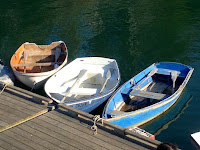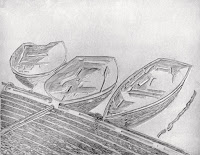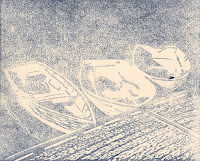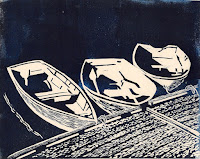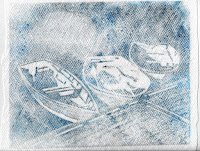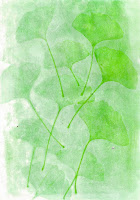Materials
- Paper: 10 sheets of 8 1/2" by 11" lightweight paper that easily folds
- Cover: 1 sheet of medium weight card stock
- Book cloth: 3" x 5 1/2"
- Thread: ~17" (3x the length of the spine)
The book has two signatures with 10 folios each. The paper is cut to make in half to make twenty 8 1/2" wide x 5 1/2" tall sheets. These pages are divided into two sets of 10 pages each. Each set of pages are folded in half and creased to make a signature that is 4 1/4" wide x 5 1/2" tall.
Cut the card stock in half to make two 8 1/2" wide x 5 1/2" tall sheets. Fold and crease each sheet in half to form 4 1/4" wide x 5 1/2" tall covers (one for the front and one for the back).
The book’s spine is made from a piece of book cloth that is folded lengthwise to form a “W”. Fold the book cloth in half lengthwise first and crease the fold. Then fold each long end back to the middle, creasing the folds.
Attach the front and back covers of the book to the book cloth so that each cover is folded over one end of the book cloth. Measure and mark 3/8" along the inside edge of each cover. Spread a thin laver of glue along the 3/8" x5 1/2" strip of one cover. Attach the cover to the outside wing of the book cloth lining the edge of the book cloth to the 3/8" line that was drawn. Spread the inside of the card stock with glue and press the two sides of card stock together. Repeat with the other piece of card stock. Press the cover flat and let dry.
Cut the card stock in half to make two 8 1/2" wide x 5 1/2" tall sheets. Fold and crease each sheet in half to form 4 1/4" wide x 5 1/2" tall covers (one for the front and one for the back).
Attach the front and back covers of the book to the book cloth so that each cover is folded over one end of the book cloth. Measure and mark 3/8" along the inside edge of each cover. Spread a thin laver of glue along the 3/8" x5 1/2" strip of one cover. Attach the cover to the outside wing of the book cloth lining the edge of the book cloth to the 3/8" line that was drawn. Spread the inside of the card stock with glue and press the two sides of card stock together. Repeat with the other piece of card stock. Press the cover flat and let dry.
Make a stitching template with three holes. One hole in the middle (2 3/4" from top), and the others 3/4" from top and bottom. Use the template to punch holes in the two signatures and the valleys of the book cloth "W".
Stitching the signatures to the book cloth. Thread the needle. Place one signature into each of the valleys of the “W”. Hold them in place using a paperclip. The two signatures will be stitched to the book cloth using a single pamphlet stitch. Open each signature so their pages are back to back. You will have one side of each signature with both covers between them in one hand and the other sides of each signature with the middle of the "W" in your other hand. Start with the middle hole and stitch through one signature, the "W" and the other signature, leaving a 1" tail. Next stitch the top holes bringing the thread back. Stitch the bottom holes. Finally stitch through the middle hole again, making sure to come up on the opposite side of the thread that runs from the top hole to the bottom hole. Tie the tail and remaining thread off.
Instead of photos of making the book, i am using photos from my notes. I keep note books on making books, printing and painting. I refer back to them often.
This same process can be used to make a larger five hole double pamphlet stitched book. There is also a version called the "split-pleat Japanese double pamphlet" which separated the front and back covers. Or you can have one continuous cover following this plan. Or just stitch two signatures together without a separate cover.



